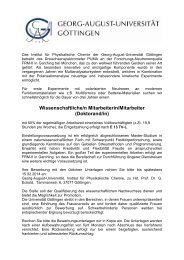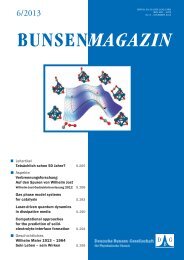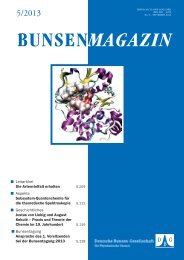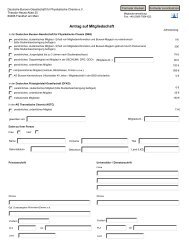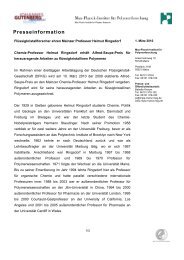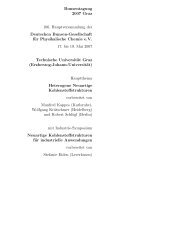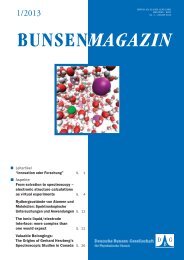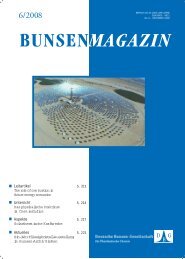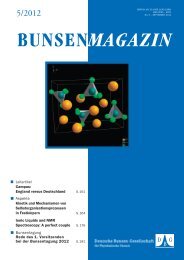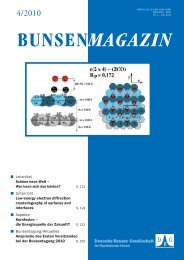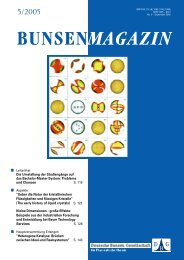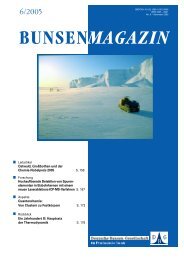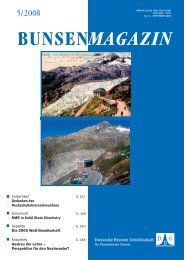BUNSENMAGAZIN - Deutsche Bunsengesellschaft für ...
BUNSENMAGAZIN - Deutsche Bunsengesellschaft für ...
BUNSENMAGAZIN - Deutsche Bunsengesellschaft für ...
Sie wollen auch ein ePaper? Erhöhen Sie die Reichweite Ihrer Titel.
YUMPU macht aus Druck-PDFs automatisch weboptimierte ePaper, die Google liebt.
DEUTSCHE BUNSEN-GESELLSCHAFT<br />
mathematically be described by second-rank tensors, where<br />
the resulting orientation-dependent NMR frequency for each<br />
of the interactions takes the form: 15,18b<br />
δ 2<br />
2<br />
ω ( α , β ) − ω L = ω iso + ( 3 cos β − 1 − η sin β cos 2 α ) . (1)<br />
2<br />
Here, w is the Larmor frequency, w is the isotropic chemical<br />
L iso<br />
shift and the other terms refl ect deviations due to angular-dependent<br />
contributions. The strength of the anisotropic interaction<br />
is specifi ed by d, and h (0≤η≤1) is the asymmetry parameter<br />
that describes the deviation from an axial symmetry. For each<br />
interaction tensor, a coordinate frame of reference (the so-called<br />
principal axes system) can be defi ned, in which the tensor is reduced<br />
to its diagonal elements. Typically, this coordinate system<br />
is directly related to the molecular framework, i.e. its z-axis is<br />
along a bond direction, or normal to an aromatic ring etc. The orientation<br />
of the respective principal axes system with respect to<br />
the external magnetic fi eld is denoted by the polar angles α, β.<br />
The most important spin interaction for achieving chemical site<br />
selectivity is the chemical shift. It results from the shielding of<br />
the magnetic fi eld at the position of the nucleus by surrounding<br />
electrons. Recently, major advances have been achieved in<br />
quantum chemical calculations of this parameter in molecules<br />
and in bulk compounds at different levels of precision and<br />
computational cost, 21,22,23,24 thereby facilitating unambiguous<br />
peak assignments and hence interpretation of experimental<br />
data. The observable NMR frequency is shifted by an isotropic<br />
contribution w iso and by angular-dependent contributions as<br />
described in (Eq. 1). In solution, angular-dependent terms are<br />
often averaged. In rigid solid samples, a so-called powder average<br />
(assuming an equal probability for all directions) yields<br />
a broad, yet characteristic NMR spectrum that refl ects the<br />
chemical-shift anisotropy (cf. Fig 2 left). 15,18 In case of an axially<br />
symmetric chemical-shift tensor, η is zero and the angulardependent<br />
term in Eq. (1) simplifi es to d(3cos 2 β-1)/2. Typically,<br />
the chemical shift in organic solids spans about 20 ppm for 1 H,<br />
200 ppm for 13 C, and 400 ppm for 15 N nuclei.<br />
For abundant nuclei with spin ½ (e.g. 1 H, 19 F) the corresponding<br />
NMR spectrum is often dominated by dipole-dipole couplings<br />
due to interactions among the magnetic moments of two<br />
neighbouring spins (note that there is no isotropic contribution<br />
and η is zero) so that Eq. (1) simplifi es correspondingly. For a<br />
two-spin system, one obtains a Hamiltonian of the form<br />
H<br />
= I I I I<br />
r<br />
⎛<br />
2<br />
μ 0⎞γγ 1 2ℏ⎛3cos<br />
θ −1⎞<br />
��<br />
= ⎜ ⎟ 3 ⎜ ⎟( 3I1<br />
I2 − I1I2) ⎝ 4π⎠<br />
r ⎝ 2 ⎠<br />
⎛<br />
2<br />
μ 0⎞γγ 1 2ℏ⎛3cos<br />
θ −1⎞<br />
��<br />
⎜ ⎟ 3 ⎜ ⎟( 3 1 2 − 1 2)<br />
⎝ 4π⎠<br />
⎝ 2 ⎠<br />
D z z<br />
12<br />
where r is the magnitude of the vector connecting the two<br />
12<br />
spins (e.g. ��<br />
I i<br />
1H-13C), θ is the angle of this vector with respect to<br />
the magnetic fi eld , the are spin operators and the g (i=1,2)<br />
i<br />
are the magnetogyric ratios of the spins. Clearly, the Hamiltonian<br />
can be separated into a spin part (the spin operators) and<br />
a so-called space part that contains angular-dependent terms.<br />
Indeed, this apparently trivial approach constitutes the basis<br />
for rather sophisticated manipulation of the Hamiltonian20 and<br />
is the key to modern solid-state NMR.<br />
The strength of the resulting line-splitting strongly depends<br />
on the distance between the two coupled spins, so that dis-<br />
(2)<br />
UNTERRICHT<br />
tance information can be extracted from such spectra. Homonuclear<br />
interactions among like spins (e.g. 1 H- 1 H, 19 F- 19 F) with<br />
g 1 = g 2 = g and heteronuclear interactions among unlike spins<br />
(e.g. 1 H- 13 C, 1 H- 15 N) with g 1 ≠ g 2 have to be distinguished. In the<br />
latter case, the so-called fl ip-fl op term that is part of the product<br />
in Eq. (2) can be safely neglected. 15 For a powdered<br />
sample, one again has to take all angles b into account yielding<br />
the so-called (dipolar) Pake spectrum, which can span larger<br />
frequency ranges than the chemical shift. Since the dipolar<br />
coupling is a through-space interaction, however, we in principle<br />
have to evaluate the sum over all possible pair interactions<br />
rendering experimental NMR line-shapes for static organic<br />
solids (or rather rigid samples) rather featureless.<br />
2.2. MAGIC-ANGLE SPINNING<br />
The most prominent technique in solid-state NMR for linenarrowing<br />
is magic-angle spinning (MAS). Here, the angular-dependent<br />
part of the interactions is modulated by rapid<br />
mechanical spinning of the sample around an axis inclined at<br />
an angle Q with respect to the magnetic fi eld. If the spinning<br />
axes is chosen along the so-called magic-angle Q m =54.7°, the<br />
relevant scaling factor (3cos 2 Θ -1)/2 becomes zero and the<br />
anisotropic part of the interaction vanishes (Fig. 2). Today, very<br />
fast MAS with rotation frequencies reaching 70 kHz 25 and more<br />
is commercially available, thus providing unprecedented high<br />
spectral resolution, particularly in solid-state 1 H and 19 F NMR.<br />
In addition, MAS largely simplifi es the network of strongly dipolar-coupled<br />
protons 26 that typically precludes the use of the<br />
dipole-dipole couplings among 1 H spins for specifi c structural<br />
investigations in non-spinning (static) solid samples. In order<br />
to effectively reduce or remove line-broadening due to anisotropic<br />
interactions, the rotation frequency w R should be larger<br />
than the magnitude of the respective anisotropic interaction<br />
(e.g. the 1 H- 1 H dipolar coupling w D ). In fact, for most organic<br />
solids, the 1 H- 1 H dipole-dipole couplings, e.g. in CH 2 groups<br />
with a proton-proton distance of 0.18 nm are of the order of<br />
w D » 2p·20.6 kHz. Thus, at fast MAS, the condition w R ≥ w D<br />
Figure 2: Effect of Magic-Angle-Spinning (MAS) on static line-shapes. Left)<br />
The static powder pattern due to chemical shift anisotropy splits into a manifold<br />
of spinning sidebands reflecting inhomogeneous broadening. Clearly,<br />
within the sideband pattern, the signal with highest intensity does not<br />
necessarily represent the isotropic chemical shift. Right) Static line-shape<br />
dominated by homonuclear dipolar couplings e.g. among abundant protons.<br />
Upon increasing MAS, the signal splits into a lesser number of spinning sidebands<br />
where the isotropic center peak is easily identified. This behaviour is<br />
referred to as homogeneous broadening. 18b<br />
63



